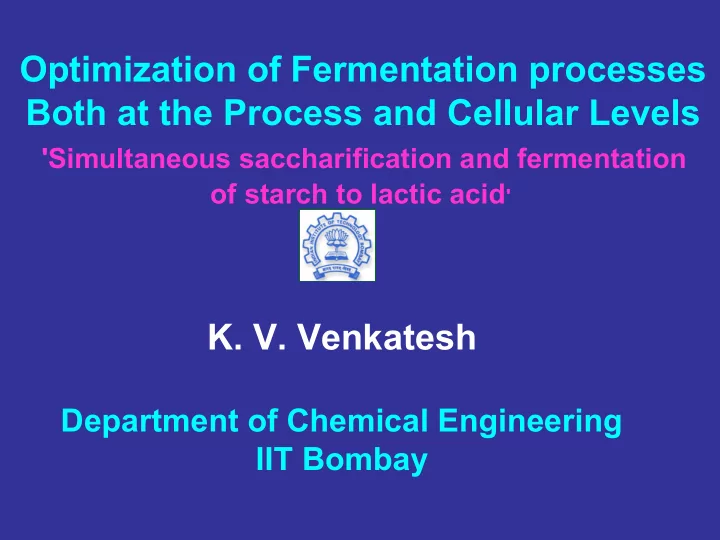

Optimization of Fermentation processes Both at the Process and Cellular Levels 'Simultaneous saccharification and fermentation of starch to lactic acid ' K. V. Venkatesh Department of Chemical Engineering IIT Bombay
Introduction • Living cells can be used to produce biochemical products • Natural screening of the environment to isolate microorganisms • Isolated microorganisms or cells as pure cultures are grown in bioreactor – fermentation processes • Fermentation processes are used to produce chemicals ranging from food, polymer, pharmaceuticals, bulk chemicals, bio-energy, waste management etc
Metabolism Cell Multiple Enzymatic Substrate Products Reactions 1. Diverse products can be produced by various living cells 2. Diversity depends on the metabolism evolved in a particular organism; Yeast – ethanol, Lactobacillus – Milk to yogurt etc
Fermentation Process • Cells/Microorganisms require a medium for its growth • Medium typically contains a carbon, nitrogen and essential nutrients • Optimal pH and temperature • Optimization at the process level: Media, environmental conditions • Operation – batch, fed-batch or continuous
Starch as a carbon Source • Starch is a polysaccharide of glucose molecules • Enzymatic hydrolysis to glucose Inhibits Alpha - amylase Gluco-amylase Glucose Dextrin Starch Rate of the enzymatic process is reduced due to glucose inhibition
Lactic acid fermentation • Lactobacillus strain converts glucose to lactic acid Glucose Lactic Acid Glycolysis Starch Lactic acid Glycolysis
Inhibition of Saccharification by fermentative products • Lactic acid Lactic Acid • Ethanol Gluco-amylase • Butanol Glucose Dextrin • Diacetyl • Acetoin • Citric acid The above products offer lesser inhibition than glucose
Simultaneous Saccharification and fermentation Gluco-amylase Dextrin Glucose Lactic Acid Glycolysis Enzymatic reaction and fermentation in the same reactor will not allow the accumulation of glucose to inhibit the saccharification step
Strategy • Detailed modeling and experimental analysis of the saccharification step • Detailed modeling and experimental analysis of the fermentation step • Prediction of optimal condition for SSF using model • Temperature (45C), pH (5.5) and glucose concentration (< 20 g/L) crucial for the operation of SSF • Experimental verification to demonstrate increased rates and productivities • Fed-batch operation for reducing product inhibition
Cellular Optimization • Cells screened from nature are typically optimized for growth • Cells are the micro-reactors in the fermentation process • The main step for economical process is to perform cellular optimization. • Metabolic and genetic engineering can be used to alter the cellular behaviour. • Directed mutation versus random mutation.
Metabolic Network analysis Metabolic Network analysis 1. Determine the limiting step in the Determine the limiting step in the 1. Metabolism Metabolism 2.Quantification of feasible metabolic space Quantification of feasible metabolic space 2. 3. Removal of the limiting step in the Removal of the limiting step in the 3. network. network. 4.Detailed Kinetics of the process using Detailed Kinetics of the process using 4. metabolism. metabolism. 5. Elementary mode analysis Elementary mode analysis 5.
What are the elementary modes ? An elementary mode is a minimal subset of enzymes in a network that can operate at steady state with all irreversible reactions proceeding in the direction as prescribed by thermodynamics. Elementary mode analysis links network structure to flux balance (evaluation of reaction rates)
Methodology: Hypothetical Network System chosen Elementary modes Kalyan Gayen and K. V Venkatesh ESBES -2006
Problem formulation Rates of external metabolites Linear programming formulation In matrix form Experimentally Determined (known) Kalyan Gayen and K. V Venkatesh ESBES -2006, Austria
Biochemical Network of Corynebacterium glutamicum Metabolites : 39 Reactions: 40 Substrates: Glucose, ammonia and oxygen Products: Lysine, Biomass, Trehalose and Carbon dioxide
Elementary Modes for the network of C. glutamicum
Elementary modes operational in Corynebacterium glutamicum Fourteen elementary modes Maximum biomass (124) Maximum Lysine (63.5) Kalyan Gayen and K. V Venkatesh BMC Bioinformatics, 2006
Flux distribution map of C. glutamicum C. glutamicum Flux distribution map of for lysine production for lysine production Optimal Biomass
Conclusions • Two level Optimization of fermentation processes – reactor and cellular • Reactor: Engineering approaches - SSF, fed- batch operation, in situ separation etc • SSF concept has been used for conversion of cellulose to biofuels • Cellular: Metabolic Engineering • Quantification of biological processes is a key step in such an application
Acknowledgement Acknowledgement 1. Prof. A. K. Suresh Prof. A. K. Suresh 1. 2. Dr. Anuradha Raghunathan (Scientist, NCL) Dr. Anuradha Raghunathan (Scientist, NCL) 2. 3. DST for funding DST for funding 3.
Thank Thank you ! you !
Recommend
More recommend